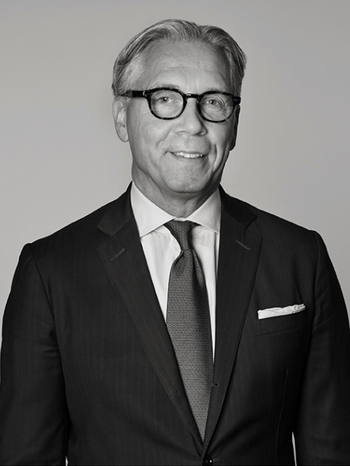Contemporary Art & Design presents Jim Dine
Jim Dine, "In the Harem, Abu Tor"
Bukowskis presents the work "In the Harem, Abu Tor" by Jim Dine at the upcoming auction Contemporary Art & Design – The Only Dedicated Live Auction in the Nordics For Contemporary Art and Design.
The painting ‘In the Harem, Abu Tor’ (1979) depicts one of Jim Dine’s most iconic subjects, the bathrobe. Bathrobes have been a central motif throughout Dine’s career as an artist and recur in many of his works. Dine started painting bathrobes in the 1960s. Although he admitted he never wore one himself, they took on the form of self-portrait early on in his career. In an interview in ARTnews in September 1977 Dine described his relationship to the magical bathrobe:
“The robes have become much more mysterious than they used to be, and that’s because I understand them more. Obviously, there’s some hidden significance there. But what’s funny is that I don’t own a bathrobe. I don’t wear one. I don’t walk around in one. I never see bathrobes around me, nor do I see people wearing them. I don’t have a bathrobe to paint from. What I use is what I’ve used from the very beginning—a newspaper ad which I clipped out of The New York Times back in 1963. The ad shows a robe with the man airbrushed out of it. Well, it somehow looked like me, and I thought I’d make that a symbol for me. Actually, it all began when I wanted to paint a self-portrait . . . and just couldn’t. It’s important for me to say this, because what I really wanted to do was sit in front of a mirror and paint a portrait of myself. But at the time, I was in analysis and the pressures I felt prevented me from going through with it.”

Jim Dine has been represented by the Pace Gallery in New York since 1976, and this was also where he first exhibited a series of large paintings of bathrobes. The colorful painting ‘In the Harem, Abu Tor’ was completed in 1979, at a time when Dine’s career had truly taken off. In the previous year he had had a retrospective one-man show at the Museum of Modern Art (MoMA) in New York. Several exhibitions were to follow and since then his work has been shown more than 300 times in institutions and galleries around the world.

The work will be sold at Contemporary Art & Design
Estimate: 800 000 – 1 000 000 SEK
Viewing: April 9–14, Berzelii Park 1, Stockholm
Open weekdays 11 AM – 6 PM, weekends 11 AM – 4 PM
Live auction: 15–16 April, Arsenalsgatan 2, Stockholm
Read more about Contemporary Art & Design
Requests & condition reports Contact specialist

Stockholm
Andreas Rydén
Head Specialist, Art, Deputy Managing Director
+46 (0)728 58 71 39

Stockholm
Louise Wrede
Specialist Contemporary Art, Private Sales
+46 (0)739 40 08 19

Stockholm
Karin Aringer
Specialist Photographs and Contemporary Art
+46 (0)702 63 70 57





























